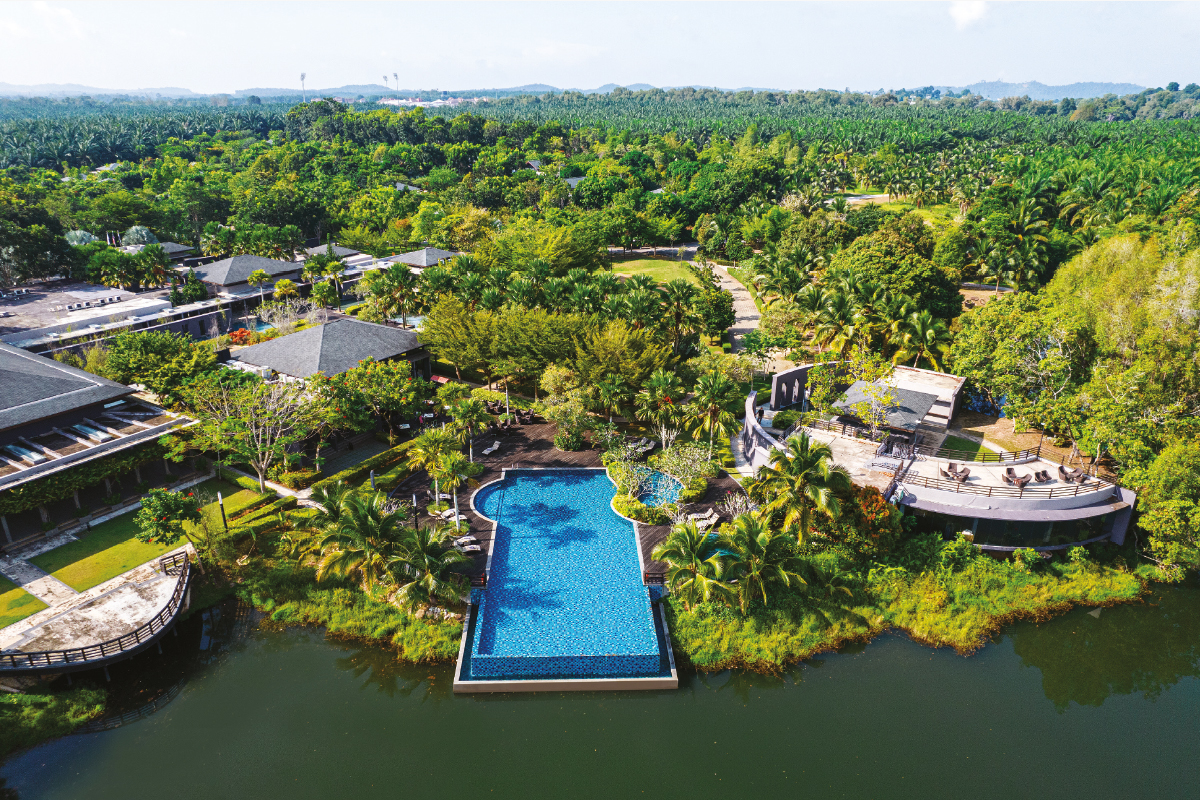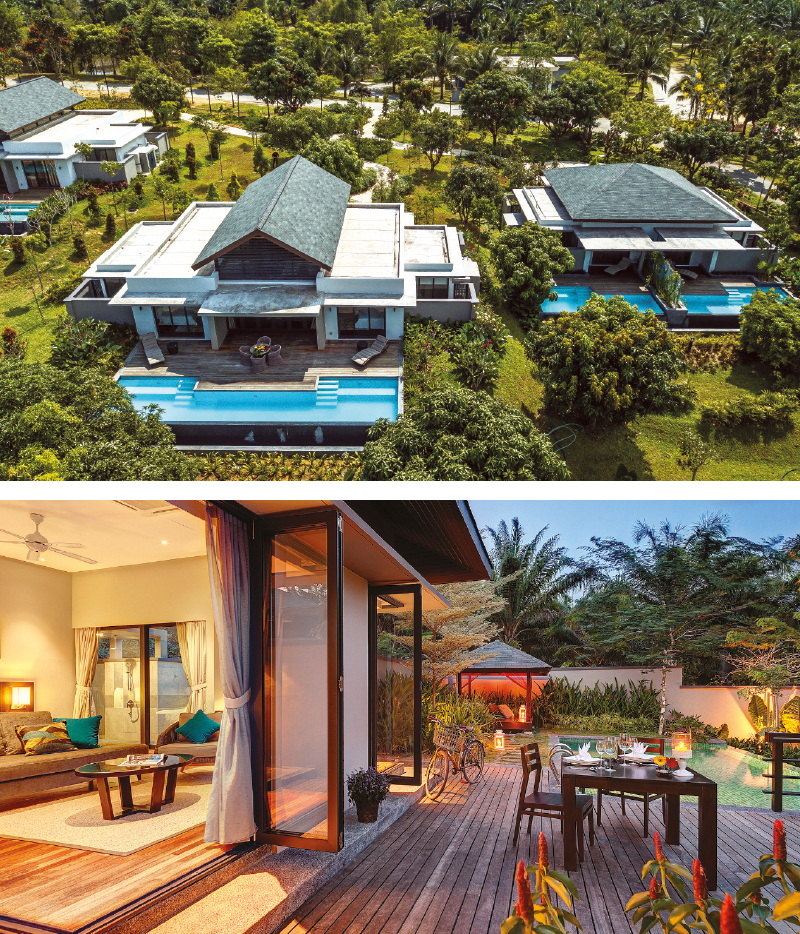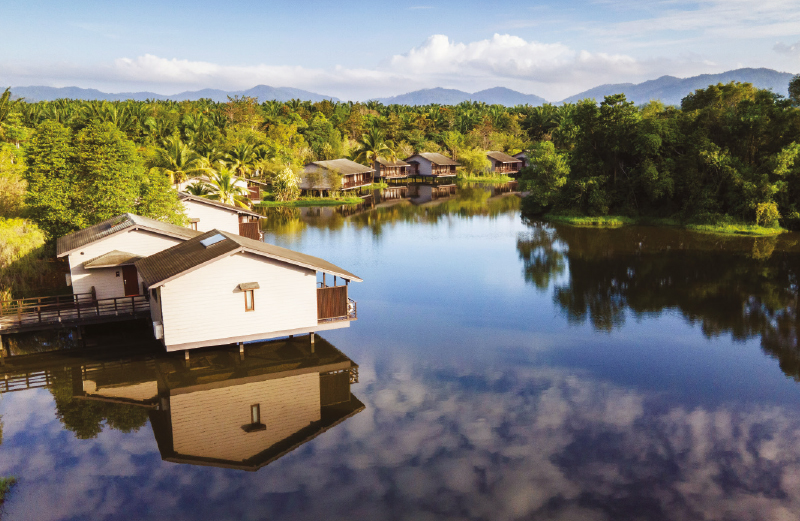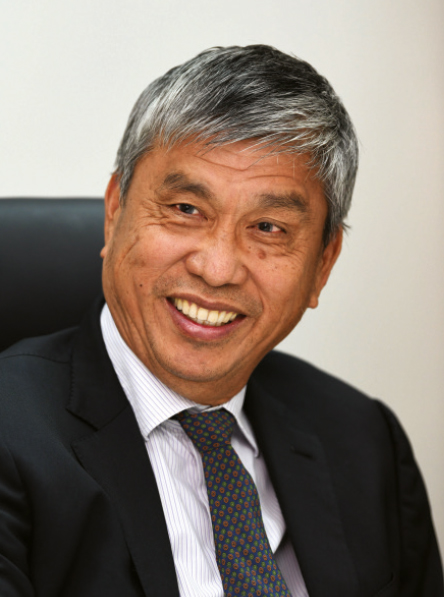
This article first appeared in City & Country, The Edge Malaysia Weekly on August 22, 2022 - August 28, 2022

Many would not have guessed that the verdant grounds on which Mangala Resort & Spa is nestled were once a disused quarry that had lain barren for many years following tin mining activities in the 1930s and sand mining from the 1970s to the 2000s.
In 2002, after Franky Group took over the 400-acre former mine in Gambang, Pahang, it spent 16 long years earnestly rehabilitating the grounds with a vision in mind — to transform the entire landscape. Today, the area is teeming with plant and wildlife.
Set within 400 acres of lush palm forest is the 60-acre Mangala Resort & Spa, a resplendent tropical oasis. It boasts a wetland, two lakes and pesticide-free fruit orchards laden with Musang King, passion fruit, pandan coconut, guava, rambutan, wild mangosteen, lime, pomelo, avocado, papaya, kedondong and more. It is also home to guest villas, a clubhouse, a spa complex and a bungalow that was originally intended as the owner’s retirement home.
The affable Franky Group managing director Datuk Franky Chua Goon Eng tells us that the resort was not in fact part of the initial plans for the land. “We did not have a big plan for it initially because the land was completely barren with a few old mining lakes. We thought of just building my retirement home there, but after we built the bungalow, I thought why not build some chalets so that others could come and enjoy the place, and we could also get some income. And that’s how we started, bit by bit,” he shares.
Rehabilitating the vast landscape was no easy feat. “We learnt the hard way. The land had a lot of gullies and holes as it was an ex-mining area, and I would say that the land was mostly clay with some sand. Only specific plants and trees, those that have a fibrous root system, could be grown. That’s why you can see many palms and coconut trees and you don’t see a lot of plants with flowers, because most flowery plants won’t last. We need plants that suit the soil conditions. I did ask plantation experts on planting in this type of soil and even they discouraged me. So sometimes, being stubborn is a good thing,” Chua quips.
Chua also had to deal with issues of flooding and erosion. “During the first five to six years, the erosion in the area was scary. Once it rains, the whole area would become like teh tarik. So, we had to divert the streams as [Sungai Belat] runs through the area, and do a lot of slope and riverbank protection using geotextile and natural boulders. We have been quite careful, so things have stabilised today.”
In addition, the old mining lakes have been turned into retention ponds and water gates have been introduced at the wetland and lakes as a safety feature to manage overflow during heavy downpours as well as during the dry season. “The old mining lakes don’t hold much water during the dry season, so with the water gates, we have managed to retain the water the whole year round. Water is extremely important because it is life. That is why [the biodiversity] is coming back,” says Chua.
The replanting exercise has significantly improved the area’s natural habitat and provided a source of food for wildlife, while the rehabilitation of the mining pools has revitalised the ecosystem for both land and water organisms.
Mangala Resort & Spa, which won the Gold award in the Landscape Planning category of The Edge Malaysia-ILAM Malaysia’s Sustainable Landscape Awards, is an oasis for hotel guests and a thriving ecosystem for flora and fauna.
One of the greatest achievements is the abundance of migrating birds, some of which are relatively rare and seldom visible elsewhere, according to Chua. “We have planted a lot of special trees and plants that attract birds and other wildlife back to the area. The oil palms are also mature now or about 18 to 20 years old.
“As verified by the BirdGroup Taman Negara, this new ecosystem supports more than 70 species of birds. The rich vegetation is also home to a variety of wildlife, including river otters, wild boars, squirrels, beavers, snakes, lizards, tortoises, frogs and dragonflies. Long tail monkeys and tapirs have also been occasionally sighted,” he adds.
A true eco-leisure destination, the resort offers recreational activities such as archery, cycling, birdwatching, kayaking and picnicking; educational nature walks; and half- or full-day tours and excursions to local attractions.
Integrating natural landscapes with building architecture
Turning in from the Segamat-Kuantan Highway to get to Mangala Resort & Spa, one can already see the grand scale of the natural environment at play while driving past dense layers of oil palm trees. This is because the natural elements take centre stage at the property, whose buildings are designed to be relatively small in scale in response to the surrounding environment.
Malik, Lip & Associates (MLA) landscape architect and director Michael Lip, who came on board the project in 2008, says: “When we first went to the site, there were already orchards, oil palms, coconut trees and water bodies that our client had put in when he first started rehabilitating the land. We studied the site and made full use of what was there at the time, including keeping the oil palms and orchards to let them grow further.
“In fact, we’ve added a road that goes through parts of the oil palm plantation to make it part of the resort experience for the guests. We have also kept the ponds and redefined the slopes very slightly to blend in with the buildings that the architects have done. Smaller roads were added so visitors can go around the site to visit the orchards and plantations,” he says.
“We have also added forest trees and semi-natural forest trees to create a more ‘jungle-y’ feel to the whole place. All the native plants are from our local nursery.”
Adopting a biophilic approach, the landscape planning at Mangala Resort & Spa focuses on integrating and creating cohesion between the built architecture and the natural landscapes. “The landscape and buildings are designed to blend together. We get a lot of natural air flow. Only the villas and the banquet hall are air-conditioned; the other common areas are naturally ventilated.
“In addition, there are buildings like the water villas that are cantilevered over the water, giving a special experience to those who stay there. The water, greenery and the whole area give a very nice, comfortable and unique experience for those who come and spend their time there,” he remarks.
The other building components at the resort are also integrated with the natural surroundings, such as the clubhouse where the private dining area, glass-panelled gym and 25m-long infinity pool overlook the lake; as well as the forest villas, wetland cottages and spa complex that are located near waterbodies and natural slopes within the resort. These built components, which are designed like pavilions, are connected via pathways that meander along the slopes and waterbodies with an aim of giving prominence to not only the destination but also the journey.
In terms of development, Phases 1 and 2 have been completed. Phase 1, which was completed in 2015, comprises a bungalow, four wetland cottages, 11 water villas, 16 forest villas, a clubhouse and spa complex; whereas Phase 2, comprising 34 orchard villas, was completed in January 2019.
Phase 3 is still on the drawing board.
Sustainability and challenges
A constant challenge for this project is the continued preservation and protection of the environment. According to the owner, monitoring is constantly conducted. Eco-friendly operational measures such as the use of buggies, bicycles and designated parking spots have also been put in place to help reduce the carbon footprint as well as to continually sustain and revive the ecosystem.
Chua says the resort adheres to a strict conservation policy that prohibits hunting and fishing. Meanwhile, the hotel uses a farm-to-table concept, utilising some of the fruits, vegetables, herbs and spices grown in the farm and orchards.
In addition to using conventional methods of construction to minimise its impact on the natural environment, the resort also uses silt traps and detention ponds to protect the natural wetland. Also, food waste is collected then decomposed to be used as fertilisers.
“And if you have noticed, there are not many mosquitoes and flies [at the resort]. This is because we use a centralised sewage system rather than septic tanks. This also helps to prevent the pollution of the waterways,” says Chua.
According to Chua, the hospitality business is a challenge on its own. “We need more tourists,” he laughs. “Firstly, the hospitality business is like a yo-yo. In terms of occupancy, we hit around 60% to 80% on weekends and public holidays, with the highest at close to 95%. The rest of the time, it is around 20% to 30%.
“When we were planning the resort, I thought there would be more corporate clients as there were not many five-star resorts in the East Coast and the oil and gas sector was very hot then. But after completing Phases 1 and 2, we now find that families love this place and they keep coming back. Our most popular room is the family room at over RM2,000 per night,” he says, adding that the units with their own private saltwater pools are also in demand.
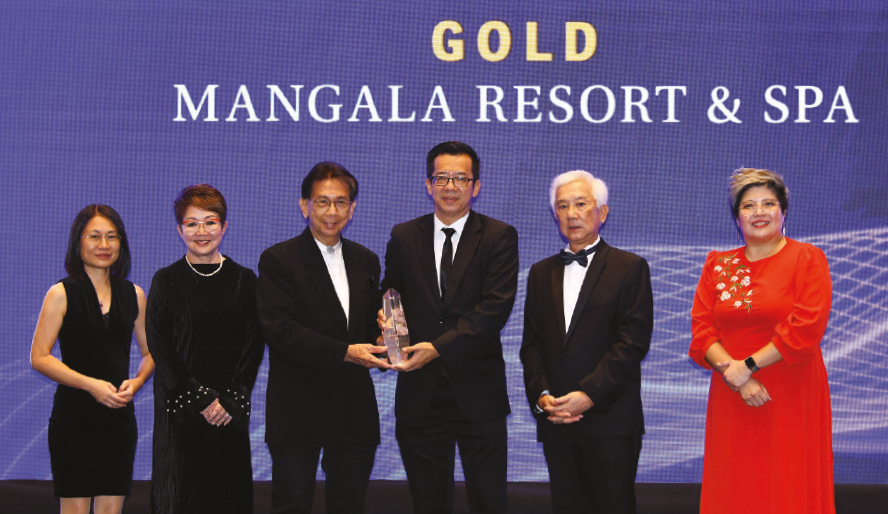
The average room rate at Mangala Resort & Spa is around RM800 per night, whereas the most expensive unit at the property is Chua’s original 2-storey bungalow with six bedrooms and a private pool at RM8,500 per night.
“There is a joke among ourselves. Last time, I used to stay there on weekends, but nowadays, you hardly see me, which is a good sign. That means we are renting [the bungalow] out every weekend,” he chuckles.
MLA’s Lip chimes in: “I just want to say that the Mangala Resort & Spa started from really nothing and [has transformed] into something so sustainable. It is a beautiful place to stay and be in. The natural ecosystem is balanced after all the efforts that have been put in so far, and I am sure that if this continues, it will be a very spectacular and iconic place in the future.”
“This is a liability turned asset,” Chua states.
Save by subscribing to us for your print and/or digital copy.
P/S: The Edge is also available on Apple's App Store and Android's Google Play.

